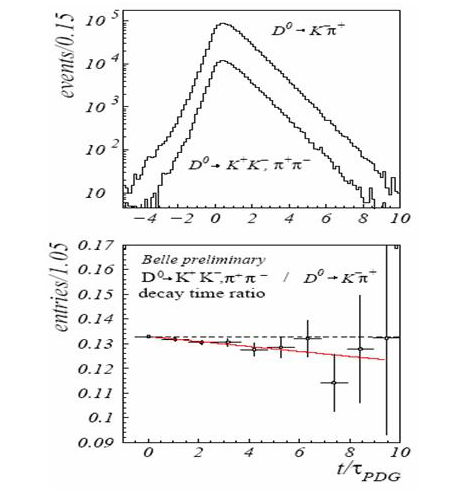Evidence for D0-D0bar Mixing Found at the Belle Experiment
March 13, 2007
The transformation of particles into their antiparticles, a phenomenon referred to as mixing, has been observed in several systems of neutral mesons: neutral kaons, Bd and most recently Bs mesons. The only system where this phenomenon is possible, but has not yet been observed, is the neutral D meson system.
In the Standard Model of particle physics D meson mixing is highly suppressed. As a result it is sensitive to the contribution of new, as of now unobserved processes and particles. Many searches for D mixing have been carried out at electron-positron colliders, proton-antiproton colliders and fixed target experiments since the discovery of D mesons in 1976.
Evidence has now been found for D0 mixing by researchers from the Belle experiment, a collaborative effort of scientists from universities and laboratories in America, Asia, Australia, and Europe. The experiment operates at the KEK High Energy Physics Laboratory in Tsukuba, Japan, which is home to the world's highest luminosity particle accelerator.
On March 13, 2007 Belle presented evidence for D0-D0bar mixing at the Rencontres de Moriond, an international high energy physics conference in LaThuile, Italy. Mixing modifies the decay times of D mesons by a small but observable amount. From a careful comparison of decay times in three decay modes of D mesons: D0->K- pi+, D0->K+ K- and D0->pi+ pi-, Belle measured the relative lifetime difference to be (1.31 +- 0.32 +- 0.25)%.
The Belle result differs from zero by 3.2 standard deviations after including systematic uncertainties. A non-zero value of a lifetime difference between different decay modes represents clear evidence for the transformation of the D0 particle into its anti-partner. Belle's measurement can now be compared with Standard Model theoretical predictions in order to search for new physics.

A small difference in the lifetimes of two sets of D meson modes is
the first evidence for D0-D0bar mixing.
Figure (a) shows the time distributions for D0->K- pi+
and the sum of D0->K- K+ and D0->pi+ pi-
(b) shows the ratio of the two time
distributions.
The deviation from zero slope in (b) is visual evidence
for D0-D0bar mixing
Also see M.Staric's talk at Moriond EW 2007 (pdf)
|



